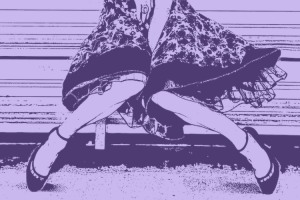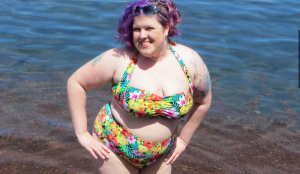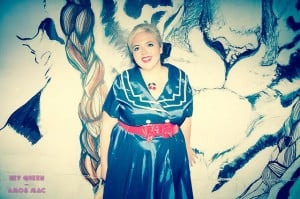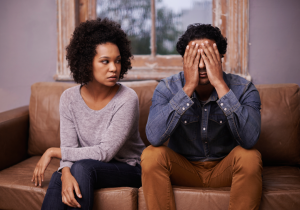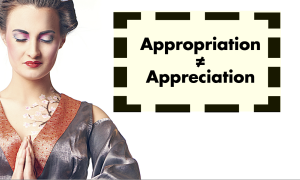
Source: Getty Images
(TRIGGER WARNING: Eating disorders.)
The year is 1998.
Big Pun’s “Still Not a Player” music video is playing from my 13-inch TV. I’m only eight years old, but I know that one day my “baby fat” will vanish, and I’ll go from “la gordita” to one of the “chula” Boricuas that Pun is rapping about.
To prepare for this day, I put on some stretchy floral leggings, the ones that make my behind look the roundest, and move my hips like the girls in the video.
Who knew that I’d still only wear jeans that “help” me fit that curvy Latina ideal at age 22?
You know which one I’m talking about. It’s the only body type Latinas in the media are allowed to have.
Big breasts, toned arms, small waists, thick hips, and thighs that touch.
Think Sofía Vergara. On second thought, think of any Latina actress, singer, or video vixen you’ve ever seen.
Although I technically pass Pun’s “fat ass and breast” test, I still don’t exactly look like the chicas in his video. I still don’t measure up to this curvy Latina stereotype.
As a teenager, it never mattered how many hours a day I’d spent exercising, my belly would never be as ripped as J-Lo’s. Regardless of all the meals I’d skip and the times I’d waste over a toilet bowl, throwing up the salad I wasn’t “strong” enough to resist, I was never able to get rid of my arm fat.
And now there’s cellulite. Ay, Dios. ¿Por qué yo?
I’ll be honest, I love not having a thigh gap. Pero Jennifer Lopez no tiene celulitis.
Or, at least, she and all of my other thick sisters don’t in their Photoshop-manipulated images and edited videos.
Oh, snap. Did you just catch that?
Curvy women of color are Photoshopped, too.
Here’s a thought. You know how the mainstream media is suddenly concerned with how manipulated images of size-0 models (you know, the ones that they’re publishing) are affecting our young girls (“our young girls” being synonymous with “white young girls”)?
Well, I think other young girls and women of color are experiencing something similar.
Except, they’re not starving themselves in an attempt to look like Kate Moss (though many girls and women of color are affected by that white beauty ideal, too, and do go to extreme measures to meet that ideal).
But rather, they’re adopting unhealthy exercise regimens and going on extreme diets to look like Salma Hayek and Kim Kardashian.
Still, regardless if the goal is to lose your butt or lift it, the desire to fit an ideal is the same – just with a different pant size.
They’re both problematic. They’re both unattainable.
In fact, the women we look up to as thinspiration, whose images are retouched and sometimes composed of body parts from different photographs (seriously – read this), often don’t meet the ideal either.
But unless you’re trying to meet the white ideal, you don’t really know that. Latinas are often left out of the body image conversation because it’s assumed that curvy bodies are healthier and more easily attained.
But that’s not true.
And ignoring body image issues among Latinas forces us to think disordered eating is okay.
After all, we’re not trying to look emaciated. No, we just want to lose our bellies and our arm fat while somehow hoping our beloved breasts and backsides swell – which is not exactly possible, naturally, that is.
But if we don’t know that, we end up thinking there’s something wrong with us if this doesn’t magically occur.
If we truly believe the only photos being edited are those of white women and that the images we see of curvy Latinas on TV are real and untouched, then we think that’s obviously an attainable body type and that there’s something wrong with us for not fitting it.
But that’s not true.
So, I have some things to tell you, hermanas.
Photos of our favorite Latina celebrities are Photoshopped, too.
Latinas of all shapes, sizes, and ages suffer from disordered eating.
Latinas are not immune from messages in the media telling us how to look.
We may not be subjects in the mainstream body positivity conversation, but we’re certainly being told how we should look – and I bet we’ve all formed the same mental image.
And, finally, regardless of how the media tells us we should look, Latina bodies – like all bodies – come in all different shapes, sizes, and colors.
Surprise, surprise, America. The bodies of Jenny, Chelsy, Kristina, and Stephanie can all be found on the block.
We’re sharing this message with young white girls across the nation. We’re teaching them to become media literate, which is great.
But it’s time we do the same for Latinas.
Pues, esto es para ti.
1. Surround Yourself with Positive People
Our friends, peers, and, in the Latino community, our familias can all have a big influence on how we feel about our bodies, so it’s important to spend time with people who aren’t critical of themselves or other girls’ and women’s bodies.
At the same time, do your best to stop saying negative things about your body out loud.
When a friend or family member makes a negative comment about her body, remind her that she’s beautiful. Set a goal with her to recognize when you’re saying negative things, and stop yourself by replacing it with a compliment for yourself or someone else.
2. Go on a Media Fast
Choose a day, a week, a month, or longer to steer clear of as much media as you can.
That way, you can see how your life is different without all of those messages and images.
And when you return to viewing and reading popular media, you will be more sensitive to the messages that hurt you and those that are unrealistic.
Tuning out of media will help you better recognize what real bodies look like all around and the wide variety of bodies that are considered attractive and desirable in your own life.
You’ll notice that it looks a lot like yours, and not so much like our Latina pop stars.
3. Be Critical of the Media, Not Yourselves or Others
Next time you’re flipping through a magazine or watching a movie, train yourself to ask important questions about what you see.
If you don’t like the answers you find, remember you can turn away from the messages that hurt you.
Ask yourself:
Do you feel better or worse about yourself when viewing or hearing this media? Do you believe the females in your life would feel better or worse about themselves after viewing or hearing this media?
Who is advertising in these pages or on this screen? (Look for ads and commercials, and you’ll see who is paying the bills for your favorite media messages.)
Who owns the TV show, movie, magazine, video game, or website you are viewing? (Research the company and its owners and you’ll find out who the powerful decision-makers are behind the scenes of your media of choice.)
Are the media you read and view promoting real health or impossible ideals meant to make you spend money and time? Who are those messages promoting impossible ideals usually speaking to?
How are women and girls presented here? Are they valued for their talents and personality? Do they look like the females in your life? Which body types are presented as beautiful or desirable?
—
And remember: If you’re a fan of hip-hop music or Big Pun, he also talked about “intelligent bachelorettes.”
So, question it all, chicas.
* Note: All of the original research in this article came from a piece by the author for Latinitas magazine.
[do_widget id=”text-101″]
Want to discuss this further? Login to our online forum and start a post! If you’re not already registered as a forum user, please register first here.
Raquel is a Latina feminist, multimedia journalist, and social media strategist based in Orlando, Florida. In just a few months, she’ll be trading in her sandals for boots to work on her MA in Women’s Studies and New Media at NYU. In addition to her work at Everyday Feminism, Raquel also heads social media for Adios Barbie and writes and edits for Latinitas magazine. Follow her on Twitter @raquelreichard.
Search our 3000+ articles!
Read our articles about:
Our online racial justice training
Used by hundreds of universities, non-profits, and businesses.
Click to learn more





